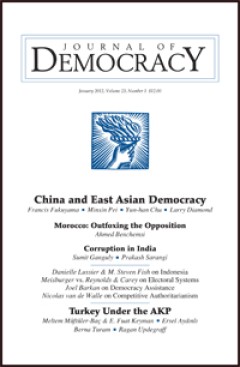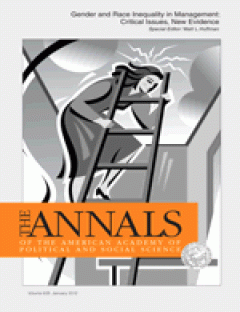Filter by

Getting Elections Wrong
Evidence from waves of democratization shows proportional election systems, however imperfect, to be the better option in most contexts.
- Edition
- Volume 23, Number 1, January 2012, pp. 164-168
- ISBN/ISSN
- 10455736
- Collation
- -
- Series Title
- Journal of Democracy
- Call Number
- -

Knowledge codification in audit and consulting firms : a conceptual and empir…
Although knowledge codification makes it possible to exchange and disseminate knowledge throughout the organization and reduce access time, enhancing the quality of engagements and relationships with clients remains problematic. We propose a model for knowledge codification built on the concepts of the service's time value and cognitive value, assessed with the aid of integrative Information Te…
- Edition
- Vol. 10, No. 1, March 2012,pp. 4–15
- ISBN/ISSN
- 14778238
- Collation
- -
- Series Title
- Knowledge Management Research & Practice
- Call Number
- -

Trust in knowledge exchanges between service providers and clients : a multip…
For some sectors, the management of client�provider knowledge exchanges is the core element of the business. This is especially the case for knowledge-intensive business services (KIBS) whose delivery entails intensive supplier�client cognitive interactions: KIBS firms supply clients with precious elements of technical and applicative knowledge, while clients give KIBS companies the knowledge i…
- Edition
- Vol. 10, No. 1, March 2012,pp. 16–26
- ISBN/ISSN
- 14778238
- Collation
- -
- Series Title
- Knowledge Management Research & Practice
- Call Number
- -

Managing knowledge within networked innovation
The purpose of this paper is to research firms� knowledge management practices within the context of networked innovation between multiple actors. The analysis is based on case research carried out with six companies. Based on earlier literature and the theoretical framework of the paper, two models of networked innovation can be distinguished according to knowledge management needs: networks f…
- Edition
- Vol. 10, No. 1, March 2012,pp. 27–40
- ISBN/ISSN
- 14778238
- Collation
- -
- Series Title
- Knowledge Management Research & Practice
- Call Number
- -

Determinants of participation in an Inuit online community of practice
An online community of practice (OCoP) is an important tool for managing and disseminating knowledge within a community. Unfortunately, research shows that OCoPs are often unsuccessful due to lack of participation by members of the community. This paper describes a preliminary investigation of the determinants that impact participation in an OCoP within an Inuit community. An open-ended intervi…
- Edition
- Vol. 10, No. 1, March 2012),pp. 41–54
- ISBN/ISSN
- 14778238
- Collation
- -
- Series Title
- Knowledge Management Research & Practice
- Call Number
- -

Open space as a knowledge metaphor and a knowledge sharing intervention
This paper addresses the role of knowledge metaphors in knowledge sharing interventions. Open space can be treated as a specific technology for blending knowledge sources and as a broader knowledge metaphor that focuses on self-regulating knowledge processes. The paper outlines the experience of applying the open space technology in a large-scale civic society initiative, �My Estonia�, in 2009 …
- Edition
- Vol. 10, No. 1, March 2012,pp. 55–63
- ISBN/ISSN
- 14778238
- Collation
- -
- Series Title
- Knowledge Management Research & Practice
- Call Number
- -

Training on the project : a quantifying approach to competence development
In the project �Competence-Driven Project Portfolio Analysis� (CDPPA), an integrated system for supporting R&D project selection, staff assignment and activity scheduling with special consideration of the strategic development of competencies has been designed and implemented prototypically. The system has been field-tested at the Electronic Commerce Competence Center (EC3), a public�private pa…
- Edition
- Vol. 10, No. 1, March 2012,pp. 64–78
- ISBN/ISSN
- 14778238
- Collation
- -
- Series Title
- Knowledge Management Research & Practice
- Call Number
- -

Knowledge management culture, strategy and process in Malaysian firms
Malaysia is one of the leading countries in Asia that are at the forefront in the development of a knowledge-based economy (KBE). The Malaysian government has been making substantial investments in both physical and technological infrastructure to facilitate knowledge-intensive economic activities. Foreign and local firms in Malaysia are encouraged to take advantage of the opportunities brought…
- Edition
- Vol. 10, No, 1, March 2012, pp. 89–98
- ISBN/ISSN
- 14778238
- Collation
- -
- Series Title
- Knowledge Management Research & Practice
- Call Number
- -

Political parties and interest groups : Disentangling complex relationships
According to a widespread assumption, party�interest group links are significantly weaker than they used to be. Both sets of organizations, it is said, now prefer autonomy over the constraints implied by close relationships, especially in supposedly �cartelized� established party systems but also in new democracies. In this article, we briefly review existing literature on party�group links and…
- Edition
- Vol. 18 no. 1, January 2012,pp. 7-25
- ISBN/ISSN
- 13540688
- Collation
- -
- Series Title
- Party Politics
- Call Number
- -

Organizational de-integration of political parties and interest groups in Den…
Political parties and major economic interest groups often used to be closely linked, but over recent decades they seem to have become more and more detached. Until now, this process has primarily been described in almost deterministic structural models that tell us little about how this detachment takes place and imply that it affects all players at around the same time. The article analyses t…
- Edition
- Vol. 18 no. 1, January 2012,pp. 27-43
- ISBN/ISSN
- 13540688
- Collation
- -
- Series Title
- Party Politics
- Call Number
- -

Party strategies towards civil society in new democracies : The Spanish case
The aim of this article is twofold. First it sheds light on the types of relationship established by political parties with interest groups in new democracies through the identification of the strategies applied by parties towards civil society. Analysis of the Spanish case allows the mapping of three different strategies: the creation and/or sponsoring (of social organizations), penetration (i…
- Edition
- Vol. 18 no. 1, January 2012, pp. 45-60
- ISBN/ISSN
- 13540688
- Collation
- -
- Series Title
- Party Politics
- Call Number
- -

Givers and takers : Parties, state resources and civil society in Portugal
This article assesses the relationship between parties and civil society in Portugal between 1999 and 2009, examining the mediating role of parties in patterns of state funding to civil society organizations. We find evidence of a relationship between parties and organized civil society � albeit an instrumental one, largely based on reward-motivated linkages. The analysis of state grants indica…
- Edition
- Vol. 18 no. 1, January 2012,pp. 61-80
- ISBN/ISSN
- 13540688
- Collation
- -
- Series Title
- Party Politics
- Call Number
- -

Interest group–party interaction in EU politics
Europe has brought about important changes in representation by strengthening the ability of national interest groups to influence policy at the expense of national political parties. Nevertheless, results from a project on the relationship between interest groups and political parties in Denmark, The Netherlands and the United Kingdom show that interest groups still attach high priority to int…
- Edition
- Vol. 18 no. 1, January 2012,pp. 81-98
- ISBN/ISSN
- 13540688
- Collation
- -
- Series Title
- Party Politics
- Call Number
- -

Minority Vulnerability in Privileged Occupations : Why Do African American Fi…
Building on recent work on contemporary forms of bias in meritocratic personnel systems, the author assesses sources of racial disadvantage in an output-based pay-for-performance system for compensating financial advisers in a large financial services firm. Using data from expert reports submitted in racial discrimination litigation, the author shows how racial differences in access to white we…
- Edition
- Vol. 639 no. 1, January 2012,pp 13-32
- ISBN/ISSN
- 00027162
- Collation
- -
- Series Title
- The ANNALS of the American Academy of Political and Social Science
- Call Number
- -

Managing Ambivalent Prejudices : Smart-but-Cold and Warm-but-Dumb Stereotypes
Not all biases are equivalent, and not all biases are uniformly negative. Two fundamental dimensions differentiate stereotyped groups in cultures across the globe: status predicts perceived competence, and cooperation predicts perceived warmth. Crossing the competence and warmth dimensions, two combinations produce ambivalent prejudices: pitied groups (often traditional women or older people) a…
- Edition
- Vol. 639 no. 1,January 2012,pp. 33-48
- ISBN/ISSN
- 00027162
- Collation
- -
- Series Title
- The ANNALS of the American Academy of Political and Social Science
- Call Number
- -

Power, Influence, and Diversity in Organizations
This article summarizes literatures on power, status, and influence in sociology�s group processes tradition and applies them to issues of diversity in organizations. Power�defined as the ability to impose one�s will even against resistance from others�results primarily from position in a social structure. Influence�defined as compelling behavior change without threat of punishment or promise o…
- Edition
- Vol. 639 no. 1, January 2012,pp. 49-70
- ISBN/ISSN
- 00027162
- Collation
- -
- Series Title
- The ANNALS of the American Academy of Political and Social Science
- Call Number
- -

Diversity within Reach : Recruitment versus Hiring in Elite Firms
Despite the popularity of diversity management, there is little consensus on how to design diversity practices that work. In this article, the author provides an inside look into one type of diversity practice: diversity recruitment. Drawing on qualitative evidence from hiring in elite law firms, investment banks, and management consulting firms, the author analyzes what diversity recruitment l…
- Edition
- Vol. 639 no. 1, January 2012,pp. 71-90
- ISBN/ISSN
- 00027162
- Collation
- -
- Series Title
- The ANNALS of the American Academy of Political and Social Science
- Call Number
- -

Developmental Practices, Organizational Culture, and Minority Representation …
Explanations of minority underrepresentation among organizational managers have focused primarily on either employee deficits in human and social capital or employer discrimination. To date, research has paid little attention to the role of developmental practices and related cultural values within organizations. Using data on large U.S. law firms, the authors investigate the role of formal dev…
- Edition
- Vol. 639 no. 1, January 2012,pp. 91-113
- ISBN/ISSN
- 00027162
- Collation
- -
- Series Title
- The ANNALS of the American Academy of Political and Social Science
- Call Number
- -

If You’re So Smart, Why Aren’t You the Boss? Explaining the Persistent Ve…
Since 1970, women have made substantial inroads into management jobs. But most women are in lower- and middle-management jobs; few are in top-management jobs. Human capital theory uses three individual-level variables to explain this vertical gender gap: women acquire fewer of the necessary educational credentials than men, women prefer different kinds of jobs than men, and women accumulate les…
- Edition
- Vol. 639 no. 1, January 2012,pp. 114-130
- ISBN/ISSN
- 00027162
- Collation
- -
- Series Title
- The ANNALS of the American Academy of Political and Social Science
- Call Number
- -

Women’s Mobility into Upper-Tier Occupations : Do Determinants and Timing D…
Data from the 1998 to 2005 waves of the Panel Study of Income Dynamics are used to assess the particularistic mobility thesis, which maintains that among women there is a racialized continuum in the determinants of and timing to mobility into two �upper-tier� occupational categories. Findings support this theory, though racial gaps along the continuum are greater for professional/technical than…
- Edition
- Vol. 639 no. 1, January 2012 ,pp. 131-148
- ISBN/ISSN
- 00027162
- Collation
- -
- Series Title
- The ANNALS of the American Academy of Political and Social Science
- Call Number
- -
 Computer Science, Information & General Works
Computer Science, Information & General Works  Philosophy & Psychology
Philosophy & Psychology  Religion
Religion  Social Sciences
Social Sciences  Language
Language  Pure Science
Pure Science  Applied Sciences
Applied Sciences  Art & Recreation
Art & Recreation  Literature
Literature  History & Geography
History & Geography